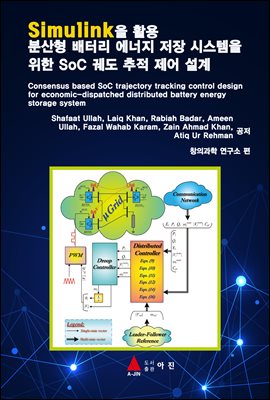
분산형 배터리 에너지 저장 시스템을 위한 SoC 궤도 추적 제어 설계
- 저자Shafaat Ullah, Laiq Khan, Rabiah Badar, Ameen Ullah, Fazal Wahab Karam, Zain Ahmad Khan,
- 출판사아진
- 출판일2020-07-13
- 등록일2020-12-21
- SNS공유


- 파일포맷PDF
- 파일크기17MB
- 공급사YES24
-
지원기기
PC
PHONE
TABLET
프로그램 수동설치
전자책 프로그램 수동설치 안내
아이폰, 아이패드, 안드로이드폰, 태블릿,
보유 1, 대출 0,
예약 0, 누적대출 8, 누적예약 0
책소개
The state-of-charge (SoC) of an energy storage system (ESS) should be kept in acertain safe range for ensuring its state-of-health (SoH) as well as higher
efficiency. This procedure maximizes the power capacity of the ESSs all the times.
Furthermore, economic load dispatch (ELD) is implemented to allocate power among
various ESSs, with the aim of fully meeting the load demand and reducing the
total operating cost. In this research article, a distributed multi-agent consensus
based control algorithm is proposed for multiple battery energy storage systems
(BESSs), operating in a microgrid (MG), for fulfilling several objectives, including:
SoC trajectories tracking control, economic load dispatch, active and reactive power
sharing control, and voltage and frequency regulation (using the leader-follower
consensus approach). The proposed algorithm considers the hierarchical control
structure of the BESSs and the frequency/voltage droop controllers with limited
information exchange among the BESSs. It embodies both self and communication
time-delays, and achieves its objectives along with offering plug-and-play
capability and robustness against communication link failure. Matlab/Simulink
platform is used to test and validate the performance of the proposed algorithm
under load disturbances through extensive simulations carried out on a modified
IEEE 57-bus system. A detailed comparative analysis of the proposed distributed
control strategy is carried out with the distributed PI-based conventional control
strategy for demonstrating its superior performance.
목차
제 1편 : SIMULINK 기본편1.1 SIMULINK의 시작 1
블록의 연결 5
블록 파라미터의 설정 7
시뮬레이션 파라미터 (Configuration Parameters)의 설정 8
시뮬레이션의 수행 9
블록 파라미터의 표시 9
복수 데이터의 표시 11
2.2 동적 시뮬레이션 13
이차 미분방정식 17
선형 상태변수 모델 23
DC 모터의 시뮬레이션 24
함수 블록의 사용 29
차분방정식(difference equation)의 모델링 34
Subsystem(부시스템)의 구성 37
제 2편 : 연구논문
Consensus based SoC trajectory tracking control design for
economic-dispatched distributed battery energy storage system
1. Introduction 41
2. Dynamic state-space model of the BESS 44
3. Consensus based distributed control strategy for BESSs 46
4. Stability analysis 51
5. Simulation results and discussion 55
6. Analysis under plug-and-play and communication link failure
events 51
7. Conclusions 57
8. References 59

















